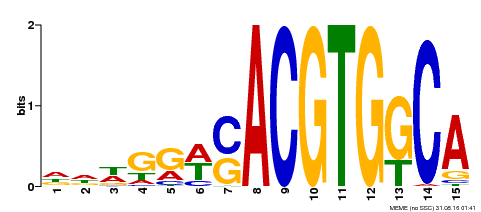 |
PlantRegMap/PlantTFDB v5.0
Plant Transcription
Factor Database
|
| Home TFext BLAST Prediction Download Help About Links PlantRegMap |
Transcription Factor Information
| Basic Information? help Back to Top | |||||||||
|---|---|---|---|---|---|---|---|---|---|
| TF ID | CCG014586.1 | ||||||||
| Organism | |||||||||
| Taxonomic ID | |||||||||
| Taxonomic Lineage |
cellular organisms; Eukaryota; Viridiplantae; Streptophyta; Streptophytina; Embryophyta; Tracheophyta; Euphyllophyta; Spermatophyta; Magnoliophyta; Mesangiospermae; eudicotyledons; Gunneridae; Pentapetalae; rosids; fabids; Malpighiales; Salicaceae; Saliceae; Populus
|
||||||||
| Family | bZIP | ||||||||
| Protein Properties | Length: 315aa MW: 35540.3 Da PI: 8.2013 | ||||||||
| Description | bZIP family protein | ||||||||
| Gene Model |
|
||||||||
| Signature Domain? help Back to Top | |||||||
|---|---|---|---|---|---|---|---|
| No. | Domain | Score | E-value | Start | End | HMM Start | HMM End |
| 1 | bZIP_1 | 52.8 | 8.8e-17 | 247 | 297 | 5 | 56 |
CHHHCHHHHHHHHHHHHHHHHHHHHHHHHHHHHHHHHHHHHHHHHHHHHHHH CS
bZIP_1 5 krerrkqkNReAArrsRqRKkaeieeLeekvkeLeaeNkaLkkeleelkkev 56
+r++r++kNRe+A rsR+RK+a++ eLe+kv Le+eN +L+ +l el+++
CCG014586.1 247 RRQKRMIKNRESAARSRARKQAYTNELENKVSRLEEENGRLR-KLRELENML 297
79****************************************.999999985 PP
| |||||||
| Protein Features ? help Back to Top | ||||||
|---|---|---|---|---|---|---|
| Database | Entry ID | E-value | Start | End | InterPro ID | Description |
| Gene3D | G3DSA:1.20.5.170 | 1.1E-13 | 239 | 294 | No hit | No description |
| SMART | SM00338 | 7.1E-13 | 243 | 309 | IPR004827 | Basic-leucine zipper domain |
| PROSITE profile | PS50217 | 11.277 | 245 | 289 | IPR004827 | Basic-leucine zipper domain |
| SuperFamily | SSF57959 | 4.5E-11 | 247 | 291 | No hit | No description |
| CDD | cd14707 | 3.98E-22 | 247 | 293 | No hit | No description |
| Pfam | PF00170 | 8.7E-13 | 247 | 290 | IPR004827 | Basic-leucine zipper domain |
| PROSITE pattern | PS00036 | 0 | 250 | 265 | IPR004827 | Basic-leucine zipper domain |
| Gene Ontology ? help Back to Top | ||||||
|---|---|---|---|---|---|---|
| GO Term | GO Category | GO Description | ||||
| GO:0006355 | Biological Process | regulation of transcription, DNA-templated | ||||
| GO:0009737 | Biological Process | response to abscisic acid | ||||
| GO:0005634 | Cellular Component | nucleus | ||||
| GO:0003700 | Molecular Function | transcription factor activity, sequence-specific DNA binding | ||||
| GO:0043565 | Molecular Function | sequence-specific DNA binding | ||||
| Sequence ? help Back to Top |
|---|
| Protein Sequence Length: 315 aa Download sequence Send to blast |
MGSQGDGSSH HVQSQFQPLV RQNSMYSLTL DEVQNQLGDL GKPLSSMNLD ELLKNVWTVE 60 AAQTTALEVE GTPLANQTAL QRQASLSLTS ALSKKTVDEV WKDIQQSKRD EEMKSKERQP 120 TFGEMTLEDF LVKAGVVAEA SVDKKDDGGS VVLVDTNAAQ QFLQQSQWVQ CPPQPQYQHP 180 QQSMVEVYMP GQPMPQPLHM GSGSMMDVSY PKNQVPLPPP LMGTLSDTQT LARKRAVPNM 240 FEKTVERRQK RMIKNRESAA RSRARKQAYT NELENKVSRL EEENGRLRKL RELENMLPCI 300 PEPKYQLRRT TSAPF |
| Functional Description ? help Back to Top | ||||||
|---|---|---|---|---|---|---|
| Source | Description | |||||
| UniProt | Binds to the embryo specification element and the ABA-responsive element (ABRE) of the Dc3 gene promoter. Could participate in abscisic acid-regulated gene expression during seed development. | |||||
| Binding Motif ? help Back to Top | |||
|---|---|---|---|
| Motif ID | Method | Source | Motif file |
| MP00409 | DAP | Transfer from AT3G56850 | Download |

| |||
| Annotation -- Nucleotide ? help Back to Top | ||||||
|---|---|---|---|---|---|---|
| Source | Hit ID | E-value | Description | |||
| GenBank | AC210341 | 0.0 | AC210341.1 Populus trichocarpa clone POP085-M05, complete sequence. | |||
| Annotation -- Protein ? help Back to Top | |||||||
|---|---|---|---|---|---|---|---|
| Source | Hit ID | E-value | Description | ||||
| Refseq | XP_011046490.1 | 0.0 | PREDICTED: ABSCISIC ACID-INSENSITIVE 5-like protein 2 | ||||
| Swissprot | Q9LES3 | 1e-86 | AI5L2_ARATH; ABSCISIC ACID-INSENSITIVE 5-like protein 2 | ||||
| TrEMBL | B9HVF2 | 0.0 | B9HVF2_POPTR; Uncharacterized protein | ||||
| STRING | POPTR_0010s25440.1 | 0.0 | (Populus trichocarpa) | ||||
| Orthologous Group ? help Back to Top | |||
|---|---|---|---|
| Lineage | Orthologous Group ID | Taxa Number | Gene Number |
| Fabids | OGEF1320 | 34 | 105 |
| Best hit in Arabidopsis thaliana ? help Back to Top | ||||||
|---|---|---|---|---|---|---|
| Hit ID | E-value | Description | ||||
| AT3G56850.1 | 7e-81 | ABA-responsive element binding protein 3 | ||||
| Publications ? help Back to Top | |||
|---|---|---|---|
|
|||



